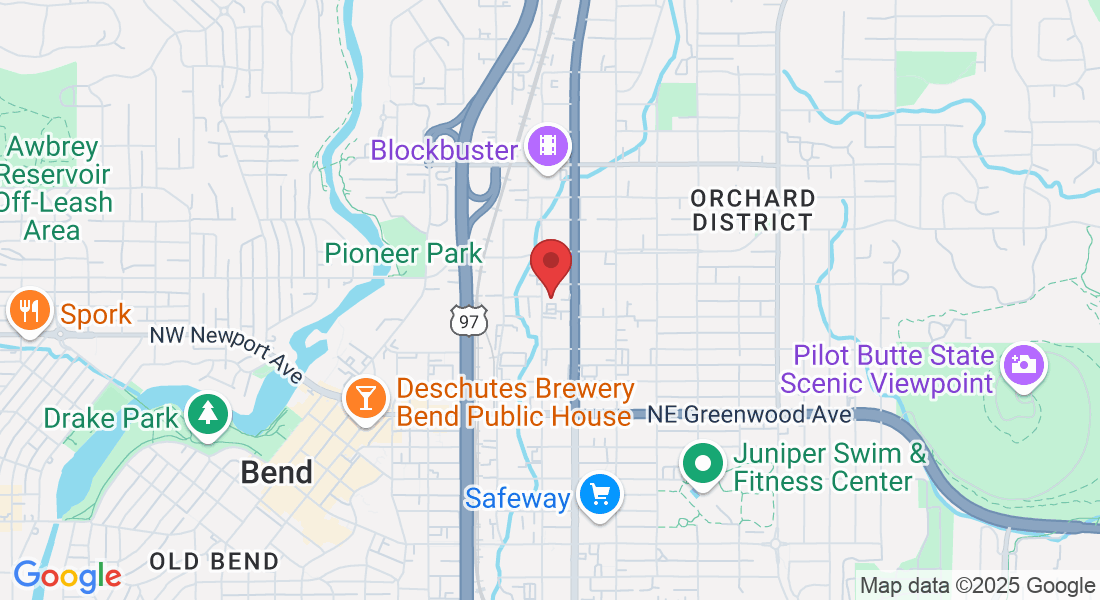Your Source for All Things Physical Therapy in Bend Oregon
The PhysioBLOG
Here, we share informative articles and insights that aim to help you achieve your full potential through our fitness-focused approach to rehabilitation. Our team is dedicated to providing you with valuable tips and techniques that can help you overcome any obstacle, whether you're recovering from an injury, surgery, or striving to build strength and wellness for life.
Stay up-to-date with our latest posts & empower yourself with elegantly simple techniques for optimal health & wellness.

HELP! My Back Went Out: A Physical Therapist’s Guide to Recovery
HELP! My Back Went Out: A Physical Therapist’s Guide to Recovery
Please Note: The information provided on our website is intended for general education and is not a substitute for professional medical advice. Each individual's situation and body are different. Therefore, what may work for one person may not work for another. We care about your well-being and advise you to reach out to us to discuss your specific needs before implementing any advice from our website. If you’d like to explore this more or would like to schedule a time with a physical therapist in Bend Oregon, contact us at PhysioFITBend.com
Introduction
The importance of a proper warm-up routine before exercising cannot be overstated. Neglecting to properly prepare your body for physical activity can lead to serious injuries, such as throwing your back out. Sometimes though, you can throw your back out simply by reaching for an object.
In the following paragraphs, we will explore the necessary steps for lower back recovery after this type of injury, providing you with the guidance you need to regain strength and prevent future setbacks. Additionally, we’lll cover unique details relating to this topic, ensuring a comprehensive understanding of the recovery process.
Causes of Back Pain
Back pain can be attributed to various factors. One major cause is poor posture, which puts excessive strain on the muscles and ligaments supporting the spine. Additionally, activities involving heavy lifting or repetitive motions can lead to back pain. Another contributing factor is a sedentary lifestyle, which weakens the core muscles that support the spine. Other potential causes include herniated discs, spinal stenosis, and osteoporosis.
Moreover, obesity and excess weight can also place extra stress on the back, leading to discomfort. Furthermore, psychological factors such as stress and depression can contribute to back pain. Additionally, smoking can hinder the flow of nutrients to spinal discs, increasing the risk of degeneration and back pain.
It is important to note that there are both acute and chronic causes of back pain. Acute back pain is often caused by sudden injuries or strains, while chronic back pain may develop over time due to underlying conditions or long-term poor habits.
Managing Back Pain and Soreness
If you're looking to effectively handle back pain and soreness, here are some expert tips to help you in your recovery journey. To alleviate discomfort in your lower back, it's important to follow a comprehensive plan designed to promote healing and alleviate pain. By implementing proper posture, engaging in targeted exercises, and seeking the guidance of a physical therapist, like us here at PhysioFIT you can actively manage your back pain and improve overall functionality.
Engaging in a regular exercise routine that focuses on strengthening the core and back muscles can provide much-needed support and stability for your spine. Additionally, adopting strategies such as using ergonomic equipment and incorporating relaxation techniques like gentle stretching and deep breathing can further aid in managing back pain and soreness. Remember, finding a personalized approach that works best for you is key in achieving long-term relief from back pain and soreness.
As you navigate your back pain and soreness management journey, it's crucial to take a proactive approach or what we call the “fitness-forward” approach. One important aspect is understanding the role of proper posture in preventing and reducing pain. By maintaining good posture throughout the day, you can minimize strain on your back muscles and help support the natural curves of your spine. Ensuring that your workspace is ergonomically set up can also make a significant difference. Consider adjusting your chair height, utilizing lumbar support, and positioning your computer monitor at eye level to promote a healthier posture.
Furthermore, incorporating core-strengthening exercises into your routine, such as planks or bridges, can improve the stability of your spine and prevent future episodes of pain and soreness.
In addition to posture and exercises, it's crucial to involve a physical therapist in your journey to managing back pain and soreness. We possess extensive knowledge and expertise in treating and rehabilitating back injuries. A physical therapist will assess your condition and create a tailored treatment plan that may include specialized exercises, manual therapy techniques, and advice on pain management strategies. Moreover, they can educate you on proper body mechanics to prevent re-injury and provide ongoing support throughout your recovery process.
A Good Night's Rest
Restful sleep is crucial for the recovery of lower back pain. Your body needs this time to repair and rejuvenate. Quality sleep promotes healing and reduces inflammation, allowing your back to heal more efficiently. It is essential to prioritize a good night's rest to aid in the recovery process.
During sleep, your body releases growth hormones that are essential for tissue repair and overall healing. By ensuring a proper sleep environment, such as a comfortable mattress and pillows that support proper alignment, you can enhance the benefits of sleep on your lower back recovery.
In addition to a supportive sleep environment, practicing good sleep hygiene is also important. This includes establishing a consistent sleep routine, avoiding caffeine and heavy meals before bedtime, and creating a calm and comfortable sleep environment. These practices will help optimize the quality and duration of your sleep, contributing to a more effective recovery process.
Furthermore, it is important to note that sleep disturbances can worsen pain and slow down the healing process. If you experience difficulty sleeping due to pain or discomfort, it is recommended to consult with a healthcare professional who can provide guidance and recommend appropriate interventions to improve your sleep quality.
Looking for Professional Help
When seeking guidance for your lower back recovery, it is important to consider consulting with a qualified professional. A skilled physical therapist can provide the expertise needed to help you safely and effectively rehabilitate your back. They can assess your condition, develop a tailored treatment plan, and guide you through exercises and techniques that promote healing and strengthen your back muscles. By working closely with a physical therapist, you can optimize your chances of a successful recovery.
When to Seek Medical Attention
It is crucial to know when to seek medical attention for your lower back injury. If you experience severe or worsening pain, loss of sensation, weakness in your legs, or difficulty controlling your bladder or bowels, it is important to consult a medical professional immediately. These symptoms may indicate a more serious condition that requires immediate attention.
In addition, if your lower back pain persists for more than a few weeks despite conservative treatments, such as rest, ice, and over-the-counter pain medications, it is advisable to seek medical advice. A healthcare provider can evaluate your condition, perform a thorough examination, and recommend appropriate diagnostic tests to determine the underlying cause of your pain.
Furthermore, if you have a history of cancer, osteoporosis, or a compromised immune system, it is essential to seek medical attention promptly when experiencing lower back pain. These pre-existing conditions may increase your risk of developing serious complications or secondary issues associated with back injuries.
To ensure proper diagnosis and timely treatment, it is important not to delay seeking medical attention for your lower back injury. By promptly addressing your symptoms, you can receive appropriate care and prevent potential long-term consequences.
Here are some suggestions to manage and alleviate lower back pain:
Rest and Immobilize: It is crucial to give your back adequate rest to facilitate the healing process. Avoid activities that worsen your pain and consider using supportive devices, such as braces or belts, to immobilize the affected area. Resting allows the injured tissues to repair themselves and reduces the risk of further aggravation.
Heat and Cold Therapy: Applying heat or cold therapy can help reduce inflammation and alleviate pain. Ice packs are recommended within the first 48 hours of the injury to reduce swelling, while heat therapy, such as warm compresses or heating pads, can aid in relaxation and promote blood circulation after the initial swelling subsides.
Physical Therapy: Engaging in specialized exercises and stretches prescribed by a physical therapist can help strengthen the muscles supporting your lower back and improve flexibility. Physical therapy sessions may also include modalities such as ultrasound or electrical stimulation to alleviate pain and promote healing.
Medications: Over-the-counter pain medications, such as nonsteroidal anti-inflammatory drugs (NSAIDs), can provide temporary relief from lower back pain. However, it is crucial to follow the recommended dosage and consult with a healthcare professional if pain persists or worsens.
Remember, seeking medical attention promptly is vital if you experience severe or worsening symptoms, have pre-existing conditions, or if your pain persists despite conservative treatments. Only a healthcare professional can provide a proper diagnosis and guide you through the appropriate course of treatment for your specific condition.
Back Pain Prevention
Maintaining a healthy back is crucial for preventing back pain. Implementing simple strategies can greatly reduce your risk of experiencing debilitating discomfort. Here are three key points to consider:
Exercise Regularly: Engaging in regular physical activity, such as stretching and strengthening exercises, can help improve the flexibility and strength of your back muscles, reducing the likelihood of pain and injury.
Maintain Proper Posture: Practicing good posture while sitting, standing, and lifting can help alleviate stress on your back and prevent strain. Ensure that your spine is properly aligned and avoid slouching or hunching over.
Lift Safely: When lifting heavy objects, it is important to use proper lifting techniques. Bend your knees, keep the object close to your body, and engage your leg muscles rather than relying solely on your back.
In addition to these points, it is essential to listen to your body and take breaks when needed. Recognize the importance of addressing any discomfort or pain promptly to prevent it from worsening.
Conclusion
It is evident that recovery from a lower back injury requires a comprehensive and tailored approach. By following the guidelines provided in the reference data, individuals can significantly improve their chances of a successful recovery. Engaging in appropriate physical therapy exercises, maintaining proper posture, and seeking professional assistance when needed are key steps towards regaining strength and mobility. Moreover, it is important to listen to one's body and refrain from overexertion, as this can potentially lead to further injury. Remember, every individual's journey to recovery may vary, so be patient and persistent in your efforts.
Overall, by adopting these strategies and remaining dedicated to the recovery process, individuals can enhance their chances of a successful lower back recovery.
Five Facts
✅ "Throwing out your back" is a common phrase used to describe back pain, stiffness, or discomfort.
✅ Back spasms and muscle strains are the most common causes of throwing out your back.
✅ Herniated discs and broken vertebrae are less common causes of throwing out your back.
✅ Over 31 million Americans deal with back pain each year.
✅ Managing back pain can involve hot and cold therapy, stretching, and the use of pain relievers.
FAQ
What does it mean when someone says they "threw their back out"?
When someone says they "threw their back out," they are referring to experiencing back pain, stiffness, or discomfort. It is not a medical term but can point to various possible conditions such as back spasms, muscle strains, herniated discs, or broken vertebrae.
What are the most common causes of back pain?
Back pain can be caused by a wide range of actions and activities. The most common causes include over-exertion, such as lifting heavy boxes or working in the garden for too long, lack of movement from prolonged sitting in a chair, and poor posture while sitting or standing.
How can I manage and alleviate my back pain and soreness?
Managing back pain and soreness involves various strategies. Hot and cold therapy, such as using heat treatments for chronic pain and stiffness or cold packs for acute injuries, can provide relief. Stretching exercises can also help increase muscle elasticity. Additionally, topical analgesics or over-the-counter pain relievers like acetaminophen can be used for pain relief.
What should I do for a good night's rest to aid in back pain recovery?
Getting quality sleep is crucial for back pain recovery. When sleeping on your back, use a moderately firm pillow under your head and feet. If you sleep on your side, place a bolster or pillow between your legs to create space and open your hips.
What are some common causes of back aches?
Common causes of back aches are over-exertion, such as lifting heavy objects or engaging in prolonged physical activities, lack of movement from sitting for extended periods, and poor posture while sitting or standing.
Please Note: It's important to note that any exercises or techniques that are shared should be performed under the guidance of a qualified bend physical therapy expert to ensure correct technique and to prevent injuries. A physical therapist can provide a customized exercise program based on the individual's fitness level, goals, and any existing injuries or conditions. If you’d like to explore this more or would like to schedule a time with a physical therapist in Bend Oregon, contact us atPhysioFITBend.com
Ask The Experts

PT, MSPT, OCS, CF-L1

PT, DPT, TPI, CF-L1

PT, DPT
Copyright PhysioFIT 2025 . All Rights Reserved


